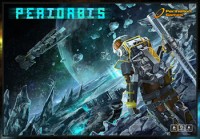
Periorbis
The following is a paid review for a current Kickstarter project.
Overview
In Periorbis your goal is to mine, transport and sell as much precious ore over the course of 12 turns (one full revolution of an immense asteroid belt). Use unique employee types to set up mining facilities on distant asteroids. Sign contracts with transport vehicles to get that ore home and sell it. Upgrade your fleet and drive technology with research to reach more distant and plentiful asteroids. The player that sells the most ore at the end of turn 12 is the winner.
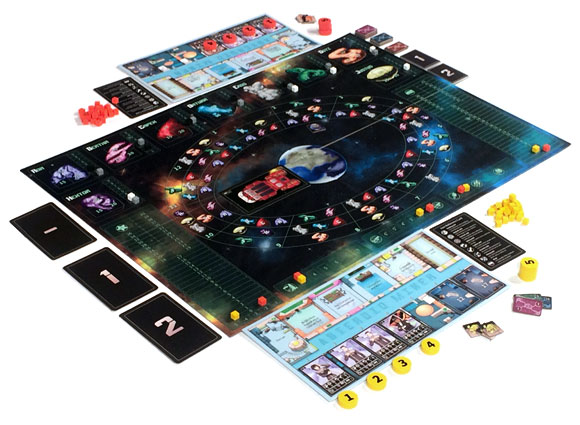
Set up
Set up is quite extensive for the game, so it is abbreviated here in the interest of getting to the good stuff.
Players begin by choosing a player color and taking all the components for that color. They also begin with one HQ board, and 50 credits (money). After all the Employee cards and Trade ship cards are sorted and set up, players place their 3 basic starting employees and one Specialist starting employee into slots 1-4 in their HQ. The Employee disks numbered 1-4 are then placed on the employees in the matching slots in that player’s HQ. The remaining employee cards are sorted by level and shuffled.
Each player then places five of their player cubes on each of the statistic tracks on the game board to show they begin with 0 Victory Points, a Fleet Capacity of three, Basic Drive technology and an Employee Wage of four. Player order is then determined by the player with the highest employee number. Finally, Ore cubes representing the three types of ore (Black, Grey and White) are placed on each of the nine asteroids which varies depending on the number of players. Your venture is ready to begin.
Employees
![]()
Everything you do in the game requires an employee to do it. Basic employees can carry out any action, but some are more skilled than others. These are called Specialists. There are five types of Specialists that receive a bonus to their specific actions: Captain, Agent, Engineer, Scientist and Miner.
Every Employee card shows what type of employee they are as well as their HQ actions skills (using icons), their Mining skill and the Wage they must be paid when they are hired.
Every employee has varying levels of ability in 7 different skills. (Building, Upgrade, Contract, Selling, Captain, Scientist and Mining) These skills are used when carrying out specific actions in your HQ (or on a mining base) during your turn.
Asteroids and Orbit Track
The asteroids you must mine are all out there floating around in orbit. All you have to do is get to them. There are nine different types of asteroids (Lettered A-J), and as the turn marker moves along the orbit track each turn, only certain types will be available that turn. In addition, there are three levels of orbit: Close (the innermost track), Medium and Far. The level of orbit you can access depends on your Drive technology. Basic Drive technology only allows you to access asteroids on the innermost track, but upgrade your technology and you can reach the Far orbit and have access to all 9 asteroids.
Fleet Capacity
To earn a wage (and score VP) you must transport your ore as cargo on a transport ship. You can also transport employees to go to the asteroids to set up mining colonies. You start with a fleet capacity of 3, but your fleet capacity can be increased during the game by carrying out research actions.
Gameplay!
Periorbis is played over the course of 12 turns. Each turn, has three phases: Hire Employees, Employee Actions, and Bureaucracy.
Hire Employees
Although skipped during the very first turn, this is where you may hire one Employee and add them to an empty space in your HQ, or replace an existing employee. To hire an employee on the first turn that they appear in the employee pool, you must pay 5x their wage. After all players in turn have purchased an employee or passed, a discount token is placed on all the employees not hired. In subsequent turns, their cost is reduced for each token on them. (The second turn after an employee appears in the pool – you must only pay 4x their wage to hire them, and so on). Hiring new employees is always recommended so you can get the best crew for your HQ.
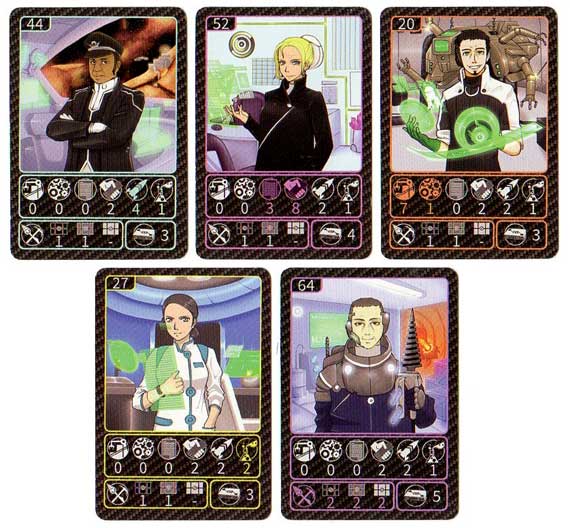
Employee Actions
There are 10 different actions that your employees can take during your turn. When an Employee takes and action, place their numbered disk in the corresponding Employee Action zone of your HQ and carry out the action. Each Employee can only perform one action per turn, but multiple employees can carry out the same action. However, at the end of the Action phase, each Employee must be paid their wage if they carried out an action this turn. If you cannot afford to pay their wage they cannot perform and action.
The 10 Actions are subdivided into 5 major categories: Engineering Actions, Agent Actions, Captain Actions, Scientist Actions and Miner Actions.
Engineering Actions
1. Build a Mining Base: Each Asteroid has three Base slots and the cost to build a Mining base on each is 10 for the first base, 15 for the second and 20 for the third. To build a base, you have to have access to that asteroid on the Orbit track. You can’t send employees to an asteroid unless there is a mining base built here. Specialist Engineers reduce the cost to build a base by their Building Skill.
2. Develop an HQ Slot: You can build a new slot in your HQ for additional employees. It costs 12 Credits to open slot #6 and 17 credits to open slot #7. Specialist Engineers reduce the cost to build an HQ slot by their Building Skill.
3. Upgrade Fleet Capacity: Spend 5 Research points to upgrade your Fleet Capacity by one allowing you to transport more cargo in a turn. Specialist Engineers reduce this cost by the value of their Upgrade Skill.
4.Upgrade Drive Technology: Spend 5 Research Data to upgrade you Drive Technology which allows you to access Asteroids in a higher orbit. Specialist Engineers reduce this cost by the value of their Upgrade Skill.
Agent Actions
5. Sign a Contract: This actions allows you to place a cube on a grey space on a transport ship so you can load ore onto it. Using an Agent specialist for this action allows you to place a bonus cubes equal to the agent’s Contact skill in the row behind the space. These will provide bonus Victory points later. The you can transport Ore on to this ship to sell in the Bureaucracy phase later in your turn.
6. Sell Ore from Storage: By selling ore crates in your HQ storage, you can get 2 Credits for each cube sold. Credits can allow you to pay employees and hire new ones. Using an Agent specialist will grant you bonus credits equal to the Agent’ s Contract skill and one Victory Point.
Captain Actions
7. Transport Cargo: Since you must have an employee on a Mining base in order to mine for ore, using this action, you can transport either Employees or ore crates to and from Asteroids. The number of employee and ore crates that can be transported is equal to your Fleet Capacity.
Crates can be transported from your mining bases to a Transport Ship as long as you have an open contract with that ship. Or you can transport ore crates to your HQ storage area. You can also sell ore crates directly to “local traders” using a Sell Ore Action.
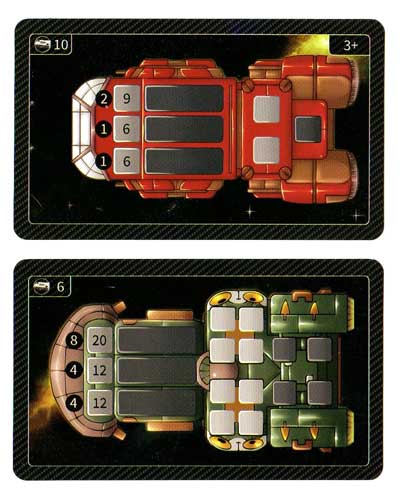
Scientist Actions
8. Research: Us this action to generate research data that will allow you to upgrade your fleet. Simply place Research cubes into the lab in HQ equal to your employee’s Research skill. Specialist Scientists have a higher Research skill than normal employees.
9. Sell Research: You can sell existing research data cubes for 10 credits each using this action.
Miner Actions
10. Mine Ore: Using an employee at a Mining base, you can convert ore (Back Grey or White) into ore crates. The Ore track for that ore is reduced by one and a number of Ore crates are placed on the mining base equal to the Mining skill of the employee taking the action.
After assigning actions to any or all employees you wish during your turn, you will then move on to the Bureaucracy Phase.
Bureaucracy Phase
There are several steps to the Bureaucracy Phase:
Trading Ships leave: Trading ships that have been supplied with ore crates leave For every crate of ore that you supplied to that ship, you receive credits equal to that ship’s standard price (in the upper left corner of the ship card) plus any agent bonus if you used a specialist. You may also receive or lose Victory points depending the number of crates you supplied over or under your contract size.
Trading Ships Arrive: Draw a new Trading ship from the deck to replace any that left this turn.
Employee Card Pool: New Employee cards are drawn and placed beside the board depending on the number of players and the number of employees already in the pool. (2 cards are drawn in a 2-4 player game, 3 cards are drawn in a 5-6 player game).
Reset Player Order: The player with the most Victory points places their cube at the right end of the Player Order track, the player with the next highest Victory Point total is placed to the left and so on until all players’ turn orders are established for the next turn.
Advance the Turn Marker: The turn marker is advanced to the next area of the orbit track, then the next turn begins with players whose cube is on the left most space on the Player order track.
Game end
The player with the most Victory points at the end of 12 turns is the victor!
Learning Curve
High. Although the turns progress in a very logical order, there is a lot to keep track of and the scoring on the trade ships can be a bit complicated. It will take several turns to get the feel of the game and even longer to be proficient at it. Take it slow.
Who would enjoy this game?
First Impressions
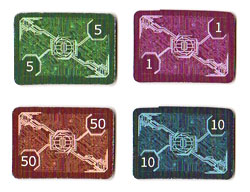
Cracking open this box you immediately know you have a lot of game on your hands. From the thick HQ boards and the hefty cardboard Credits to the wooden player markers, cubes and hundreds of cards. Then you open the large colorful game board and you immediately know this is a game you must play.
Set up does take some time, but once completed the players will embark on a journey of industry that feels unique and quite adventurous all at the same time. Most of the action in the game takes place in your own personal HQ which is certainly a defining factor of the game. Running your own inter-asteroidal mining company gives you a sense of power and accomplishment. This is certainly a worker placement game in the tradition of other Euro games that are focused on industry, but in Periorbis there are some unique qualities.
The first is the use of Employees with varying skills and specialties. Having multiple employees in your HQ with varying skill sets really adds variance to your game experience every time you play. There are over 90 employee cards and the opportunity to have the same skill sets among your employee from game to game is very unlikely. And even if one were to try to find a dominant strategy in attempting to hire certain employees from game to game, the choices in employees to hire occur randomly from the Employee deck each game. Perhaps most importantly, the actions necessary to scoring Victory points are very elegantly spread across the five different specialist employee skills. Striving to have one of each specialist in your HQ is preferable but not necessary. And there is variance even among the same specialist types. In other words, in every game your HQ takes on its own “personality” with strengths and weaknesses based on the varying employee skills. You then have to alter your strategy to accommodate these strengths and weaknesses.
Another unique feature is the Asteroid Field and Orbit Track. Using a “Turn marker” is nothing new, however incorporating the movement of the turns with the lazy motion of an orbiting asteroid belt creates a great feel to the game. It also presents some unique game challenges. Since you can only access the asteroids shown in the sector for that turn, you must plan ahead so that you can pick up employees, miners, ore, crates, etc. when that asteroid makes its next orbit on a future turn. (For example, you can build a mining base on the C (Red) asteroid on the first turn, but you won’t be able to access it again until turn 3) Add to this the fact that the asteroids move in and out from three different orbital positions (Close, Medium and Far), you must improve your drive technology to be sure to reach your mining bases as well as un-mined asteroids later in the game. The entire game feels like it’s in motion – even without the benefit of gears on the game board.
As was mentioned the scoring, using trade ships does seem a bit hard to grasp at first, but in several turns it’s easy to see this is where the money is to be made and hopefully you have a specialist employee to help you sign those contracts. In this way too, the scoring opportunities change as different Trade ships appear from a random deck, keeping the game fresh.
Finally, the availability of ore varies depending on the number of players which also varies the game experience. Although each asteroid type has relatively the same type of ore, the quantity of the ore varies. In addition, there are three different types of ore and employees will be more or less proficient in mining certain types. Matching the type of ore you can most easily mine with easily accessible asteroids that are with the type of ore you need is a true challenge. And you thought mining was just digging in the dirt!
Almost Final Thoughts
The greatest attraction with Periorbis is that it succeeds in blending a unique theme with a worker placement and economic game. The theme does shine through and you feel like you are managing your HQ and tracking the asteroid field as it makes its slow orbit around your home world. Every interaction your employees take is crucial to the success of your venture. The complexity of options and variances of gameplay actions will keep you on your toes. It’s a good choice for those cube pushers who want to attempt a challenging venture off world.
Support this game on kickstarter.com!
{Backing ends September 4th, 2:00am MDT}
Go now >
User Reviews (0)
Add a Review for "Periorbis"
You must be logged in to add a review.


Be the First to Add a Review!